Charles E W Bean, Diaries, AWM38 3DRL 606/248/1 - 1917 - 1931 - Part 4
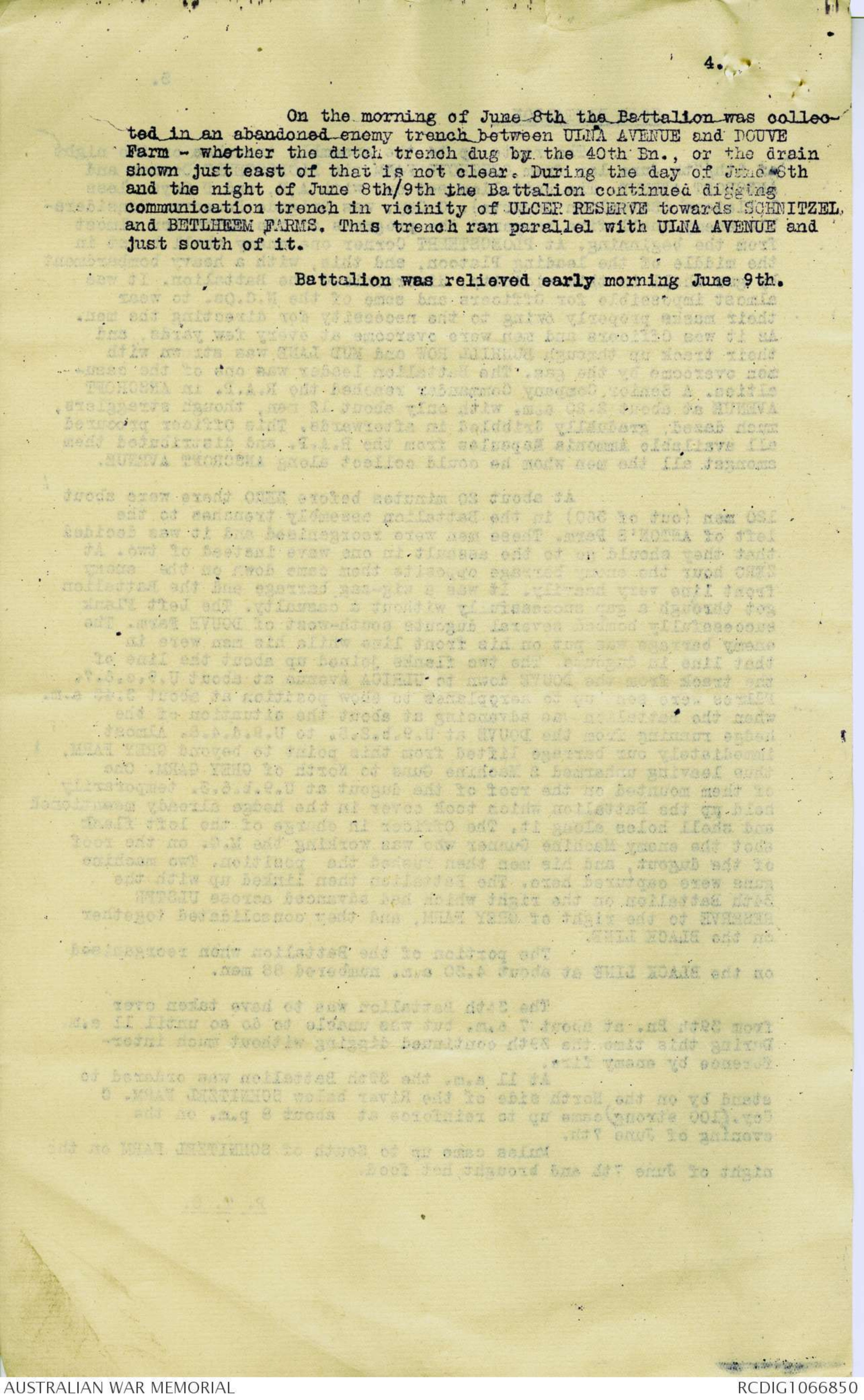
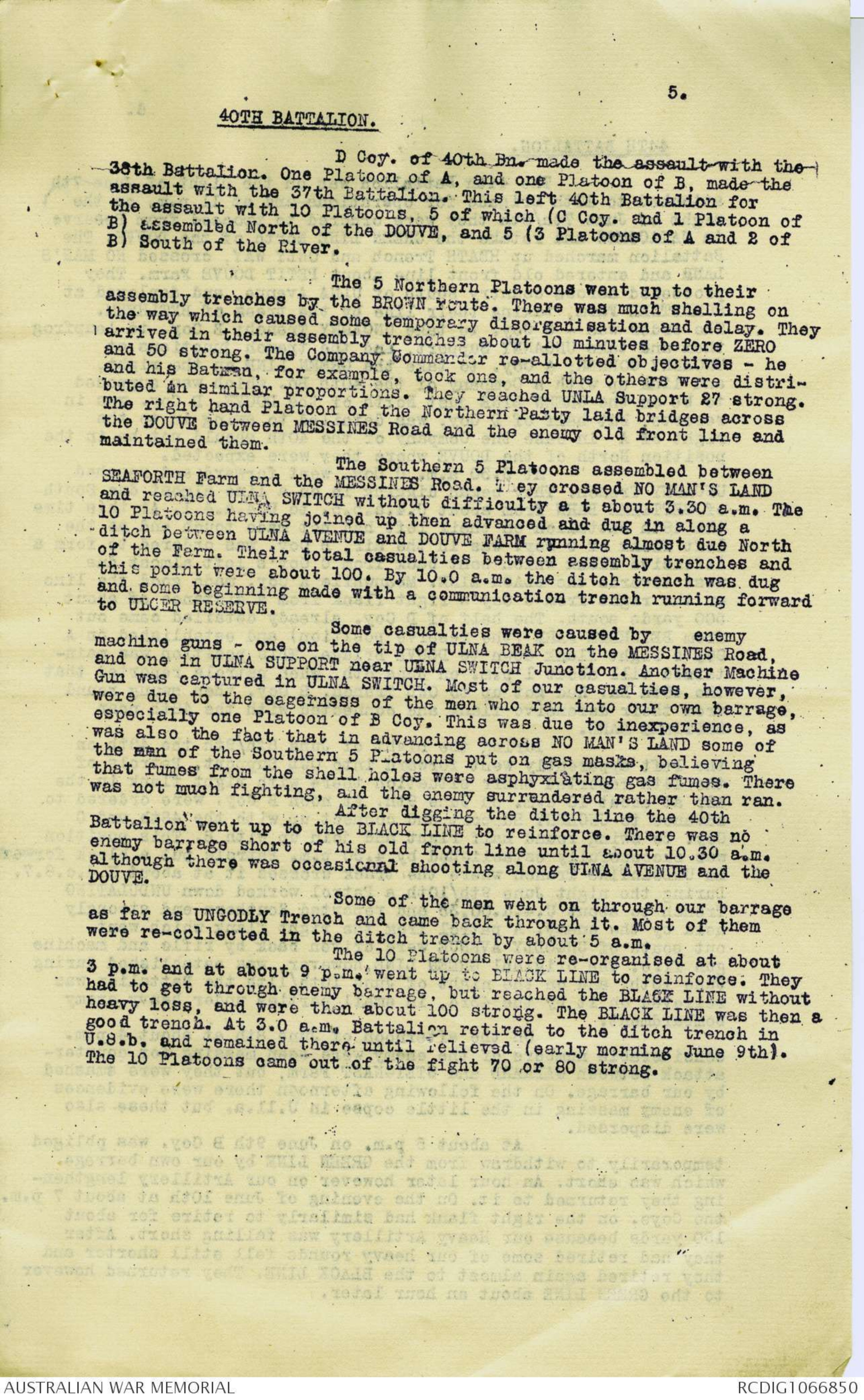
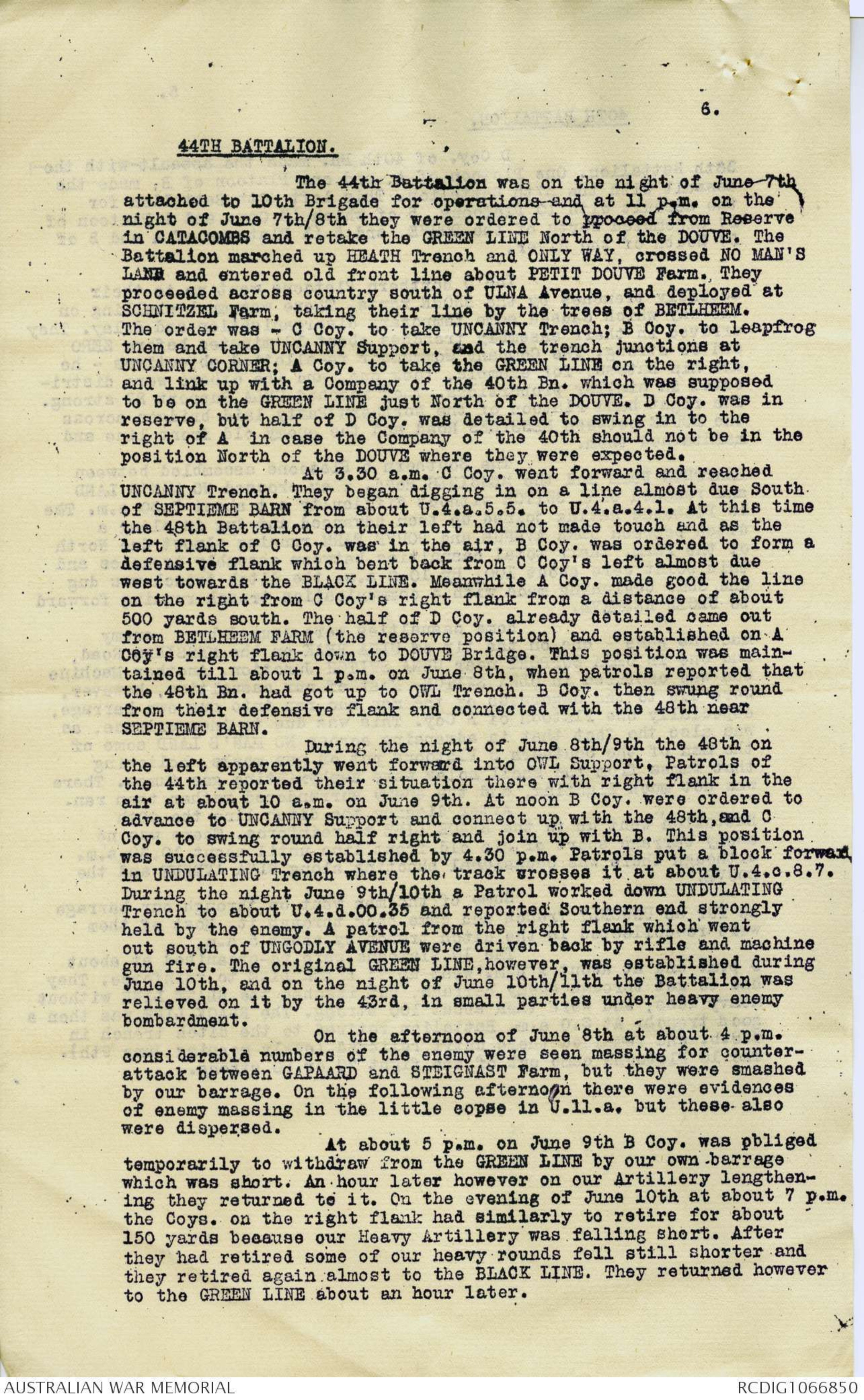
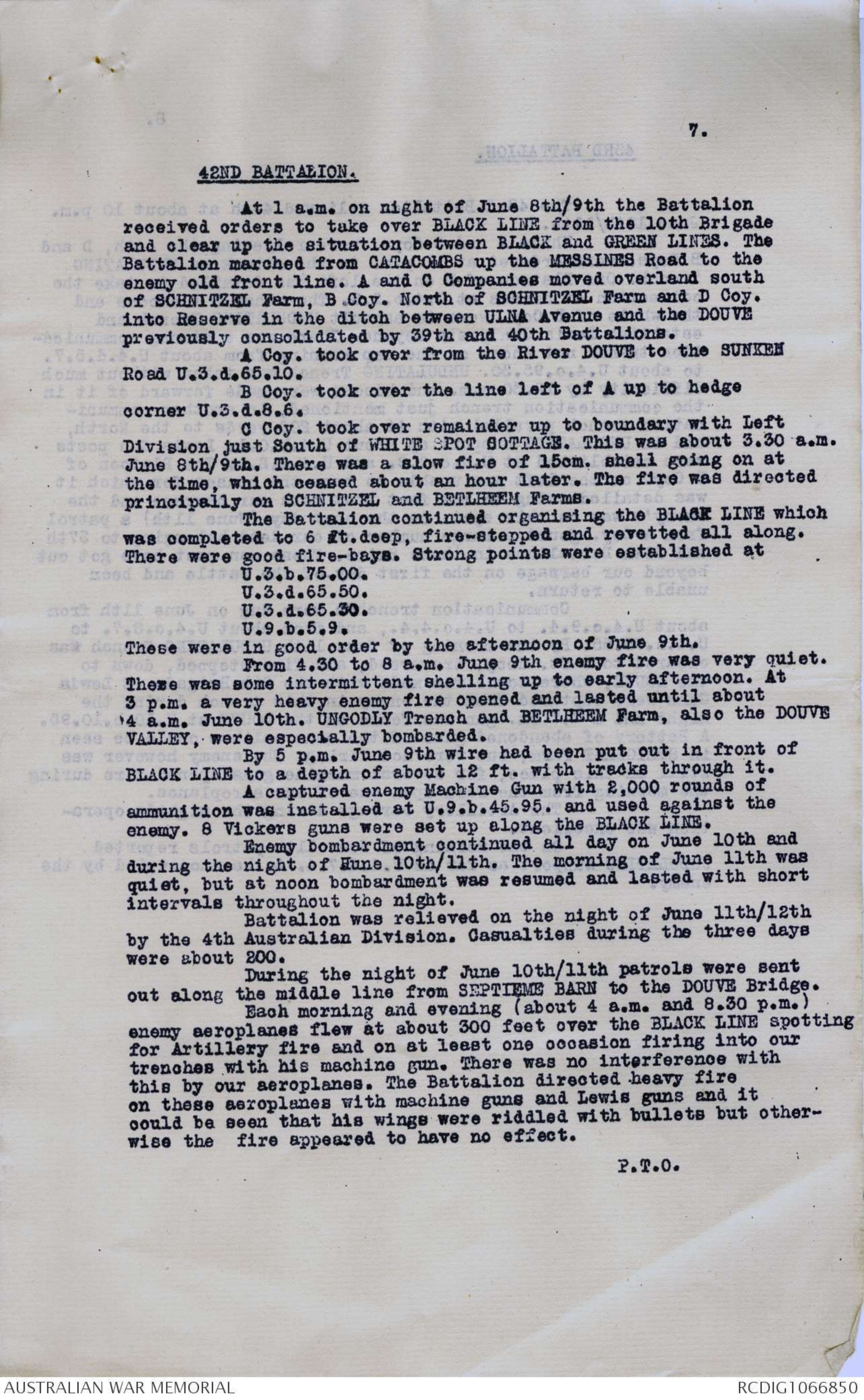
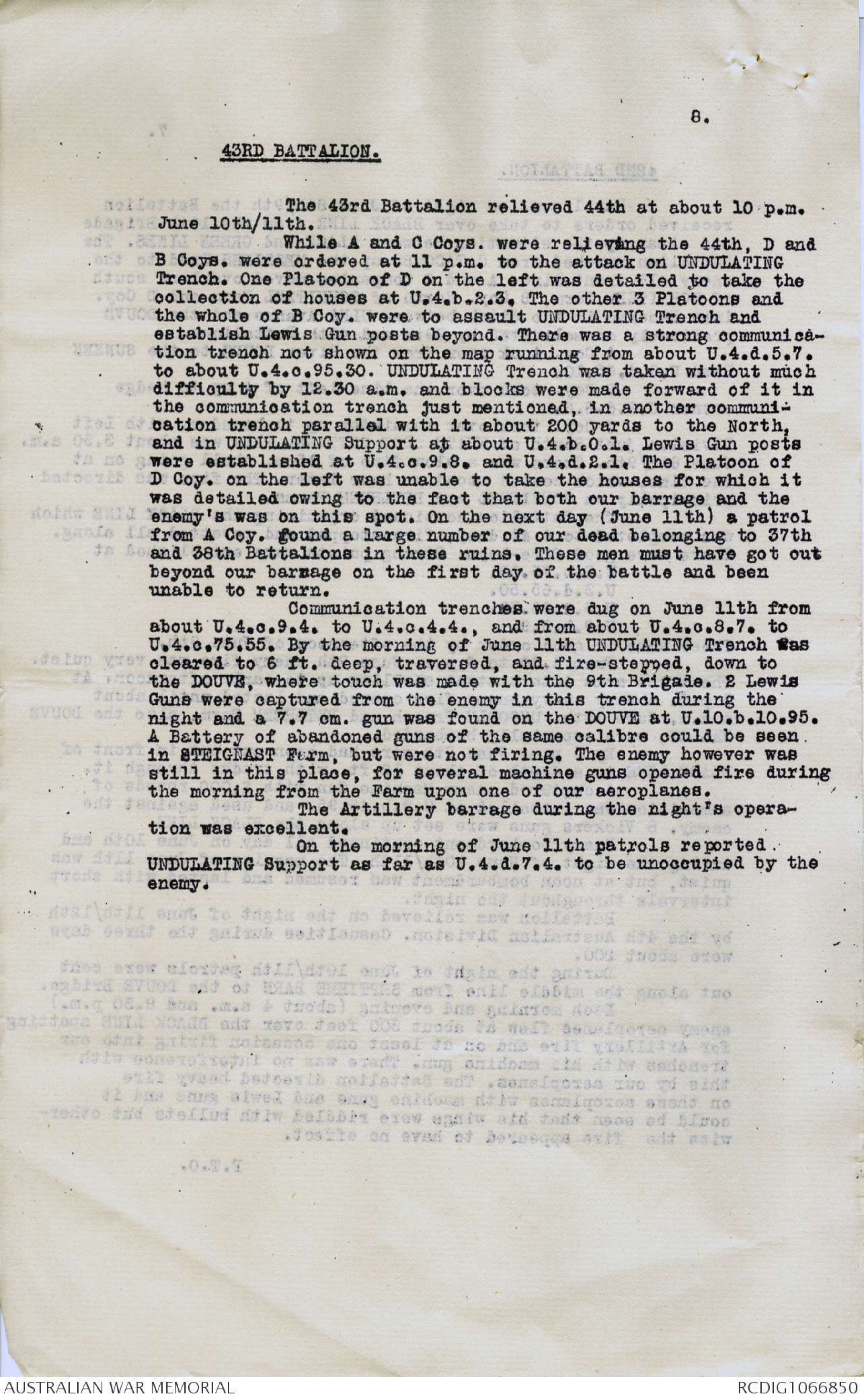
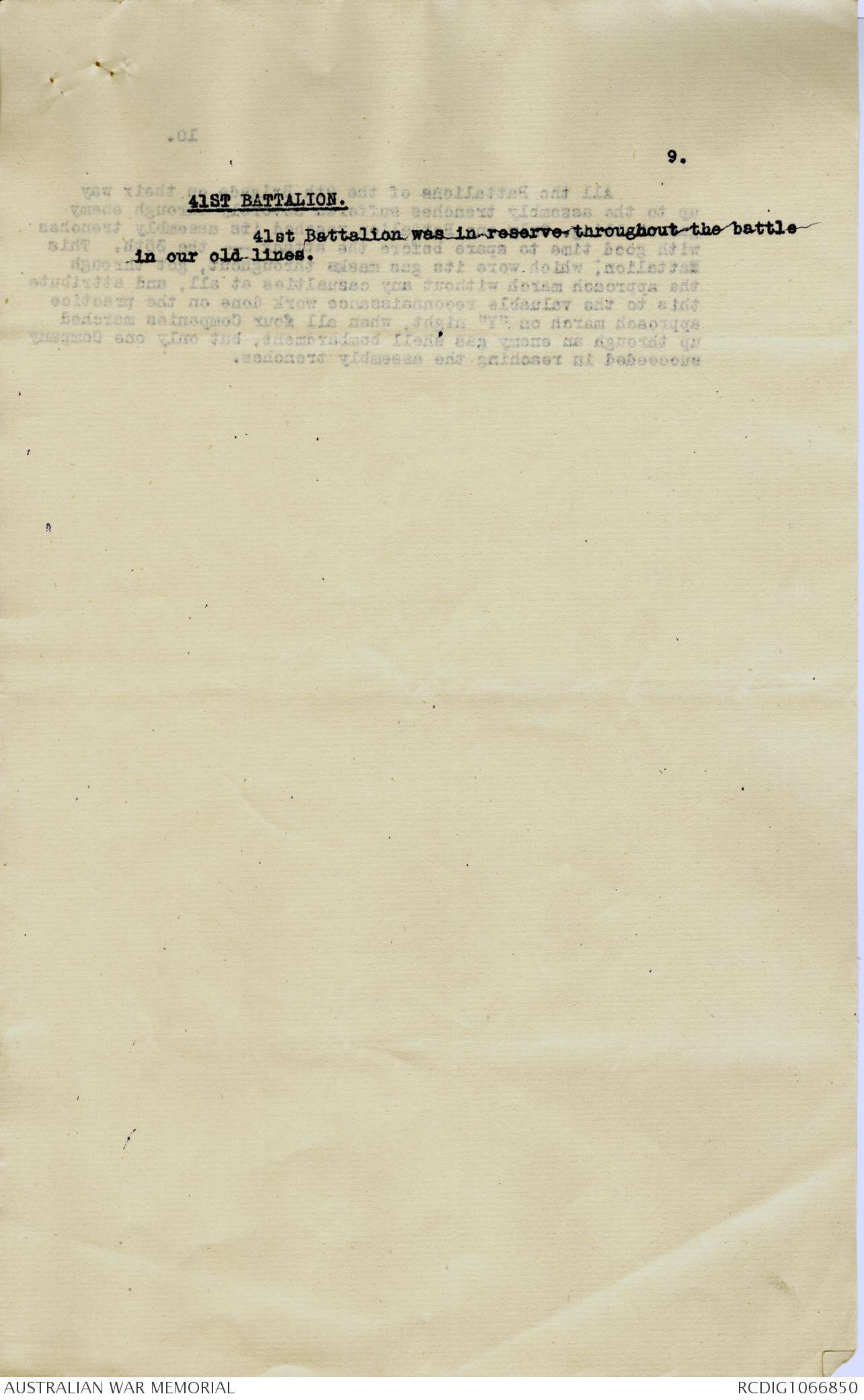

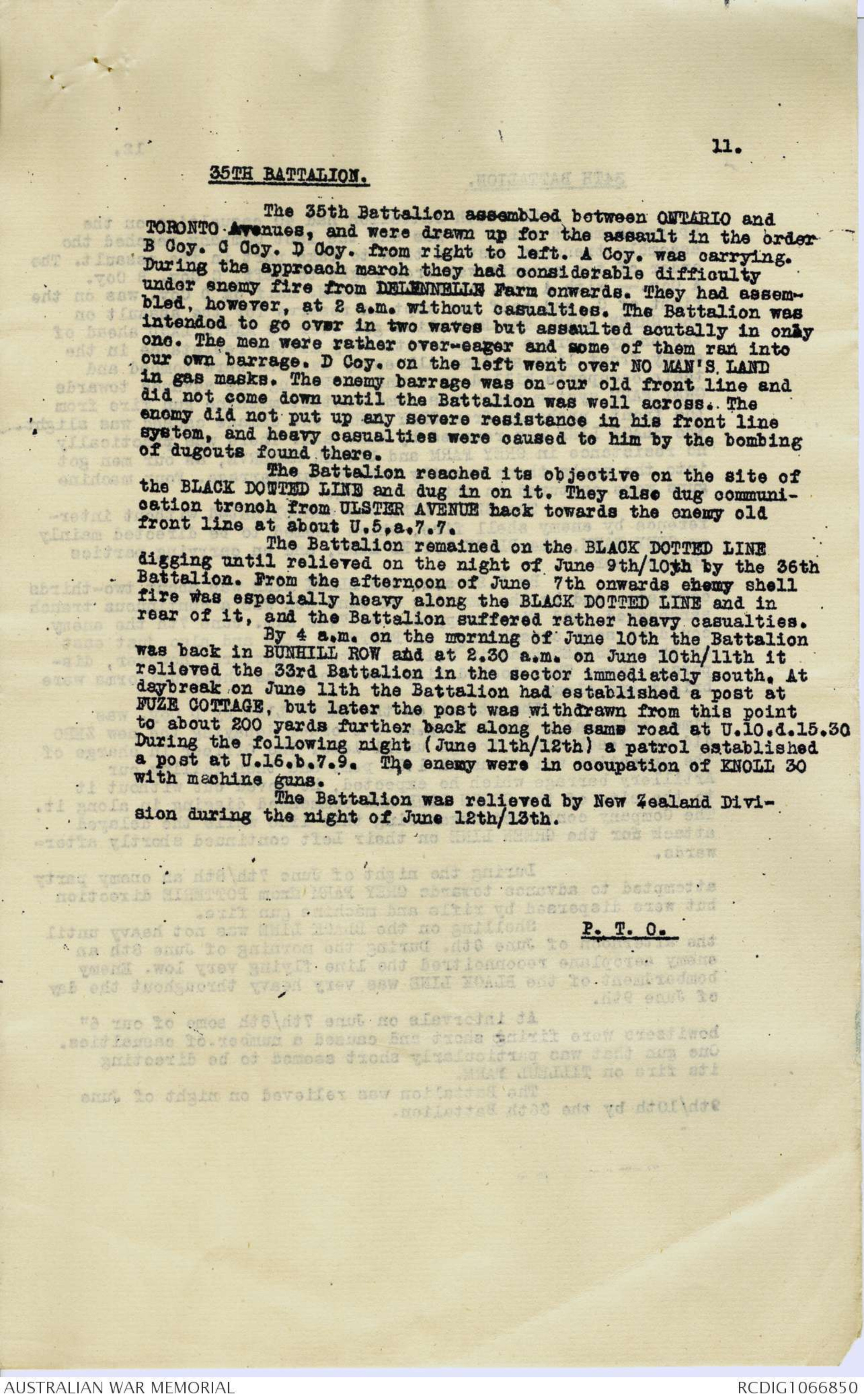
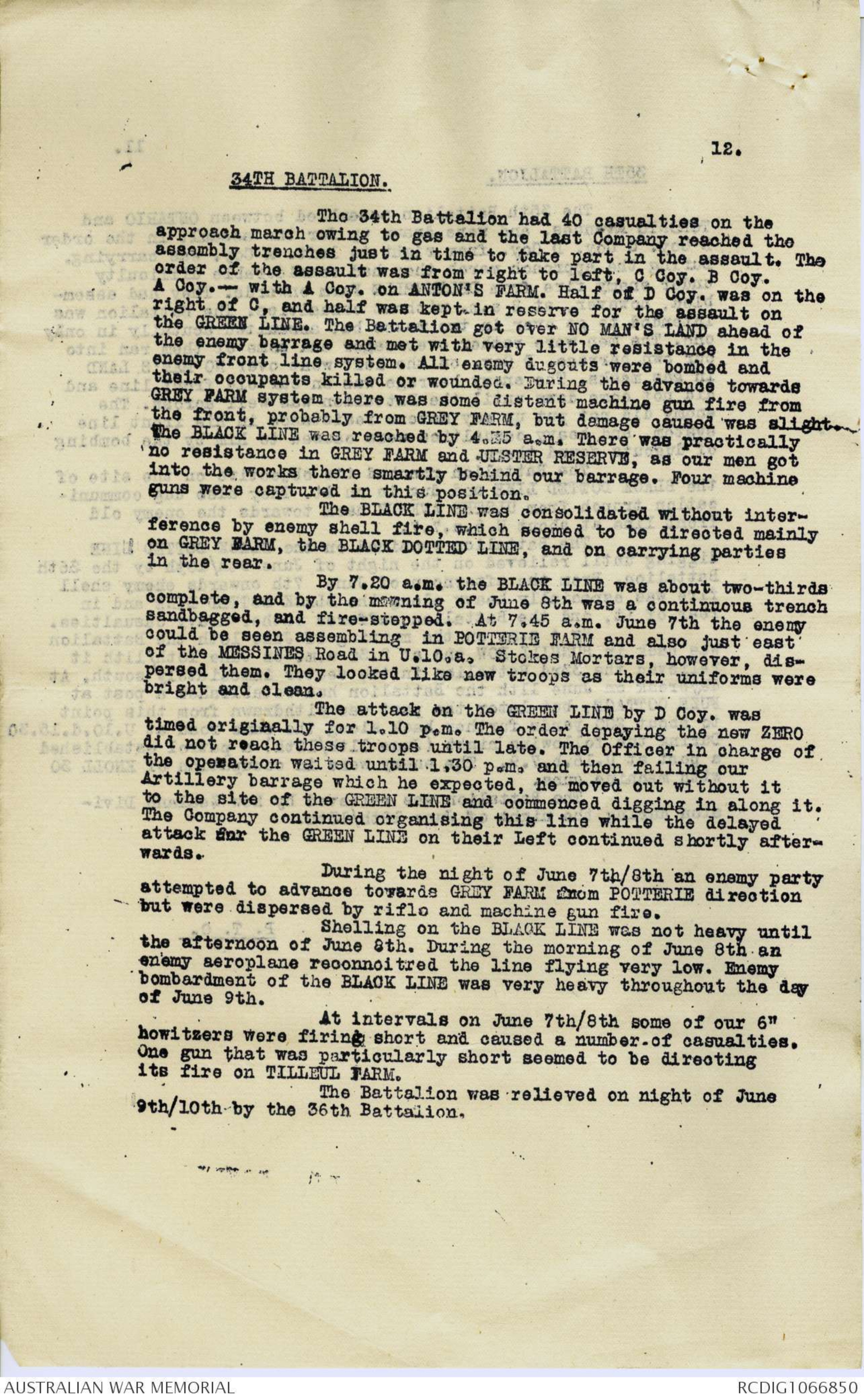
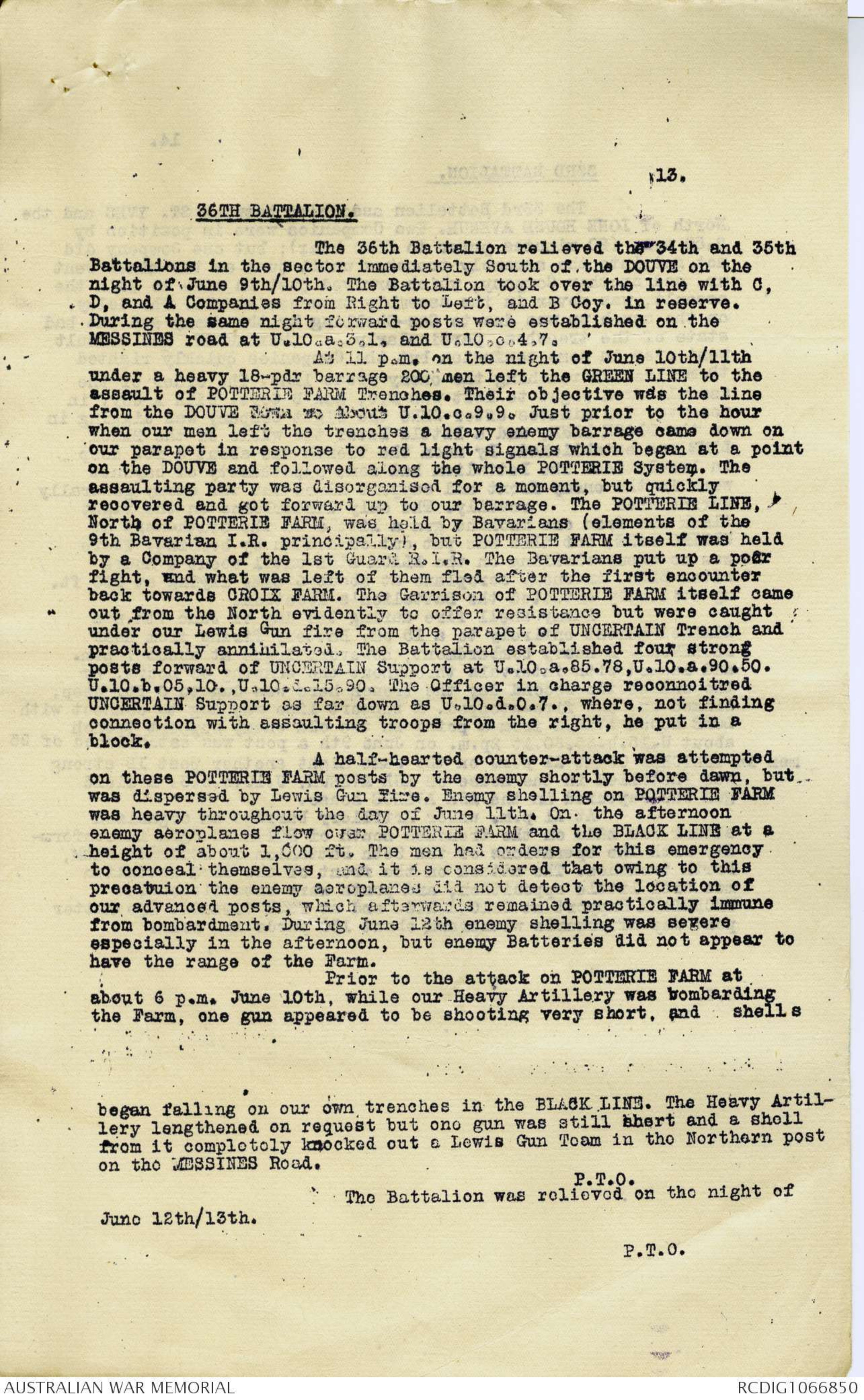
4.
On the morning of June 8th the Battalion was collected
in an abandoned enemy trench between ULNA AVENUE and DOUVE
Farm - whether the ditch trench dug by the 40th Bn., or the drain
shown just east of that is not clear. During the day of June 8th
and the night of June 8th/9th the Battalion continued digging
communication trench in vicinity of ULCER RESERVE towards SCHNITZEL,
and BETLHEEM FARMS. This trench ran parallel with ULNA AVENUE and
just south of it.
Battalion was relieved early morning June 9th.
5.
40TH BATTALION.
D Coy. of 40th Bn. made the assault with the
38th Battalion. One Platoon of A, and one Platoon of B, made the
assault with the 37th Battalion. This left 40th Battalion for
the assault with 10 Platoons, 5 of which (C Coy. and 1 Platoon of
B) assembled North of the DOUVE, and 5 (3 Platoons of A and 2 of
B) South of the River.
The 5 Northern Platoons went up to their
assembly trenches by the BROWN route. There was much shelling on
the way which caused some temporary disorganisation and delay. They
arrived in their assembly trenches about 10 minutes before ZERO
and 50 strong. The Company Commander re-allotted objectives - he
and his Batman, for example, took one, and the others were distributed
in similar proportions. They reached UNLA Support 27 strong.
The right hand Platoon of the Northern Party laid bridges across
the DOUVE between MESSINES Road and the enemy old front line and
maintained them.
The Southern 5 Platoons assembled between
SEAFORTH Farm and the MESSINES Road. They crossed NO MAN'S LAND
and reached ULNA SWITCH without difficulty a t about 3.30 a.m. The
10 Platoons having joined up then advanced and dug in along a
ditch between ULNA AVENUE and DOUVE FARM running almost due North
of the Farm. Their total casualties between assembly trenches and
this point were about 100. By 10.0 a.m. the ditch trench was dug
and some beginning made with a communication trench running forward
to ULCER RESERVE.
Some casualties were caused by enemy
machine guns - one on the tip of ULNA BEAK on the MESSINES Road
and one in ULNA SUPPORT near ULNA SWITCH Junction. Another Machine
Gun was captured in ULNA SWITCH. Most of our casualties, however,
were due to the eagerness of the men who ran into our own barrage,
especially one Platoon of B Coy. This was due to inexperience, as
was also the fact that in advancing across NO MAN'S LAND some of
the men of the Southern 5 Platoons put on gas masks, believing
that fumes from the shell holes were asphyxiating gas fumes. There
was not much fighting, and the enemy surrendered rather than ran.
After digging the ditch line the 40th
Battalion went up to the BLACK LINE to reinforce. There was no
enemy barrage short of his old front line until about 10.30 a.m.
although there was occasional shooting along ULNA AVENUE and the
DOUVE.
Some of the men went on through our barrage
as far as UNGODLY Trench and came back through it. Most of them
were re-collected in the ditch trench by about:5 a.m.
The 10 Platoons were re-organised at about
3 p.m. and at about 9.p.m. went up to BLACK LINE to reinforce. They
had to get through enemy barrage, but reached the BLACK LINE without
heavy loss, and wore then about 100 strong. The BLACK LINE was then a
good trench. At 3.0 a.m. Battalion retired to the ditch trench in
U.8.b. and remained there until relieved (early morning June 9th).
The 10 Platoons came out of the fight 70 or 80 strong.
6.
44TH BATTALION.
The 44th Battalion was on the night of June 7th
attached to 10th Brigade for operations and at 11 p.m. on the
night of June 7th/8th they were ordered to ppoceed from Reserve
in CATACOMBS and retake the GREEN LINE North of the DOUVE. The
Battalion marched up HEATH Trench and ONLY WAY, crossed NO MAN'S
LAND and entered old front line about PETIT DOUVE Farm. They
proceeded across country south of ULNA Avenue, and deployed at
SCHNITZEL Farm, taking their line by the trees of BETLHEEM.
The order was - C Coy. to take UNCANNY Trench; B Coy. to leapfrog
them and take UNCANNY Support, and the trench junctions at
UNCANNY CORNER; A Coy. to take the GREEN LINE on the right
and link up with a Company of the 40th Bn. which was supposed
to be on the GREEN LINE just North of the DOUVE. D Coy, was in
reserve, but half of D Coy. was detailed to swing in to the
right of A in case the Company of the 40th should not be in the
position North of the DOUVE where they were expected.
At 3.30 a.m. C Coy. went forward and reached
UNCANNY Trench. They began digging in on a line almost due South
of SEPTIEME BARN from about U.4.a.5.5. to U.4.a.4.1. At this time
the 48th Battalion on their left had not made touch and as the
left flank of C Coy. was in the air, B Coy. was ordered to form a
defensive flank which bent back from C Coy's left almost due
west towards the BLACK LINE. Meanwhile A Coy. made good the line
on the right from C Coy's right flank from a distance of about
500 yards south. The half of D Coy. already detailed came out
from BETLHEEM FARM (the reserve position) and established on A
Coy's right flank down to DOUVE Bridge. This position was maintained
till about 1 p.m. on June 8th, when patrols reported that
the 48th Bn. had got up to OWL Trench. B Coy. then swung round
from their defensive flank and connected with the 48th near
SEPTIEME BARN.
During the night of June 8th/9th the 48th on
the left apparently went forward into OWL Support, Patrols of
the 44th reported their situation there with right flank in the
air at about 10 a.m. on June 9th. At noon B Coy. were ordered to
advance to UNCANNY Support and connect up with the 48th. and C
Coy. to swing round half right and join up with B. This position
was successfully established by 4.30 p.m. Patrols put a block forward,
in UNDULATING Trench where the track crosses it at about U.4.c.8.7.
During the night June 9th/10th a Patrol worked down UNDULATING
Trench to about U.4.d.00.35 and reported Southern end strongly
held by the enemy. A patrol from the right flank which went
out south of UNGODLY AVENUE were driven back by rifle and machine
gun fire. The original GREEN LINE, however, was established during
June 10th, and on the night of June 10th/11th the Battalion was
relieved on it by the 43rd, in small parties under heavy enemy
bombardment.
On the afternoon of June 8th at about 4.p.m.
considerable numbers of the enemy were seen massing for counter-attack between GAPAARD and STEIGNAST Farm, but they were smashed
by our barrage. On the following afternoon there were evidences
of enemy massing in the little copse in U.11.a. but these also
were dispersed.
At about 5 p.m. on June 9th B Coy. was obliged
temporarily to withdraw from the GREEN LINE by our own barrage
which was short. An hour later however on our Artillery lengthening
they returned to it. On the evening of June 10th at about 7 p.m.
the Coys. on the right flank had similarly to retire for about
150 yards because our Heavy Artillery was falling short. After
they had retired some of our heavy rounds fell still shorter and
they retired again almost to the BLACK LINE. They returned however
to the GREEN LINE about an hour later.
7.
42ND BATTALION.
At 1 a.m. on night of June 8th/9th the Battalion
received orders to take over BLACK LINE from the 10th Brigade
and clear up the situation between BLACK and GREEN LINES. The
Battalion marched from CATACOMBS up the MESSINES Road to the
enemy old front line. A and C Companies moved overland south
of SCHNITZEL Farm, B. Coy. North of SCHNITZEL Farm and D Coy.
into Reserve in the ditch between ULNA Avenue and the DOUVE
previously consolidated by 39th and 40th Battalions.
A Coy. took over from the River DOUVE to the SUNKEN
Road U.3.d.65.10.
B Coy. took over the line left of A up to hedge
corner U.3.d.8.6.
C Coy. took over remainder up to boundary with Left
Division just South of WHITE SPOT COTTAGE. This was about 3.30 a.m.
June 8th/9th. There was a slow fire of 15cm. shell going on at
the time, which ceased about an hour later. The fire was directed
principally on SCHNITZEL and BETLHEEM Farms.
The Battalion continued organising the BLACK LINE which
was completed to 6 ft.deep, fire-stepped and revetted all along.
There were good fire-bays. Strong points were established at
U.3.b.75.00.
U.3.d.65.50.
U.3.d.65.30.
U.9.b.5.9.
These were in good order by the afternoon of June 9th.
From 4.30 to 8 a.m. June 9th enemy fire was very quiet.
These was some intermittent shelling up to early afternoon. At
3 p.m. a very heavy enemy fire opened and lasted until about
4a.m. June 10th. UNGODLY Trench and BETHLHEEM Farm, also the DOUVE
VALLEY, were especially bombarded.
By 5 p.m. June 9th wire had been put out in front of
BLACK LINE to a depth of about 12 ft. with tracks through it.
A captured enemy Machine Gun with 2,000 rounds of
ammunition was installed at U.9.b.45.95. and used against the
enemy. 8 Vickers guns were set up along the BLACK LINE.
Enemy bombardment continued all day on June 10th and
during the night of June. 10th/11th. The morning of June 11th was
quiet, but at noon bombardment was resumed and lasted with short
intervals throughout the night.
Battalion was relieved on the night of June 11th/12th
by the 4th Australian Division. Casualties during the three days
were about 200.
During the night of June 10th/11th patrols were sent
out along the middle line from SEPTIEME BARN to the DOUVE Bridge.
Each morning and evening (about 4 a.m. and 8.30 p.m.)
enemy aeroplanes flew at about 300 feet over the BLACK LINE spotting
for Artillery fire and on at least one occasion firing into our
trenches with his machine gun. There was no interference with
this by our aeroplanes. The Battalion directed heavy fire
on these aeroplanes with machine guns and Lewis guns and it
could be seen that his wings were riddled with bullets but otherwise
the fire appeared to have no effect.
P.T.O.
8.
43RD BATTALION.
The 43rd Battalion relieved 44th at about 10 p.m.
June 10th/11th.
While A and C Coys. were relieving the 44th, D and
B Coys. were ordered at 11 p.m. to the attack on UNDULATING
Trench. One Platoon of D on the left was detailed to take the
collection of houses at U.4.b.2.3. The other 3 Platoons and
the whole of B. Coy. were to assault UNDULATING Trench and
establish Lewis Gun posts beyond. There was a strong communication trench not shown on the map running from about U.4.d.5.7.
to about U.4.c.95.30. UNDULATING Trench was taken without much
difficulty by 12.30 a.m. and blocks were made forward of it in
the communication trench just mentioned, in another communication
trench parallel with it about 200 yards to the North,
and in UNDULATING Support at about U.4.b.0.1. Lewis Gun posts
were established at U.4.c.9.8. and U.4.d.2.1. The Platoon of
D Coy. on the left was unable to take the houses for which it
was detailed owing to the fact that both our barrage and the
enemy's was on this spot. On the next day (June 11th) a patrol
from A Coy. found a large number of our dead belonging to 37th
and 38th Battalions in these ruins. These men must have got out
beyond our barrage on the first day of the battle and been
unable to return.
Communication trenches were dug on June 11th from
about U.4.c.9.4. to U.4.c.4.4., and from about U.4.c.8.7. to
U.4.c.75.55. By the morning of June 11th UNDULATING Trench was
cleared to 6 ft. deep, traversed, and fire-stepped, down to
the DOUVE, where touch was made with the 9th Brigade. 2 Lewis
Guns were captured from the enemy in this trench during the
night and a 7.7 cm. gun was found on the DOUVE at U.10.b.10.95.
A Battery of abandoned guns of the same calibre could be seen
in STEIGNAST Farm, but were not firing. The enemy however was
still in this place, for several machine guns opened fire during
the morning from the Farm upon one of our aeroplanes.
The Artillery barrage during the night's operation
was excellent.
On the morning of June 11th patrols reported
UNDULATING Support as far as U.4.d.7.4. to be unoccupied by the
enemy.
9.
41ST BATTALION.
41st Battalion was in reserve throughout the battle
in our old lines.
10.
All tho Battalions of the 9th Brigade on their way
up to the assembly trenches suffered severely through enemy
gas shelling. Only one Battalion reached its assembly trenches
with good time to spare before the attack – the 35th. This
Battalion, which wore its gas masks throughout, got through
the approach march without any casualties at all, and attribute
this to the valuable reconnaissance work done on the practice
approach march on "Y" night, when all four Companies marched
up through an enemy gas shell bombardment, but only one Company
succeeded in reaching the assembly trenches.
11.
35TH BATTALION.
The 35th Battalion assembled between ONTARIO and
TORONTO Avenues, and were drawn up for the assault in the order
B Coy. C Coy. D Coy. from right to left. A Coy. was carrying.
During the approach march they had considerable difficulty
under enemy fire from DELENNELLE Farm onwards. They had assembled, however, at 2 a.m. without casualties. The Battalion was
intended to go over in two waves but assaulted acutally in only
one. The men were rather over-eager and some of them ran into
our own barrage. D Coy. on the left went over NO MAN'S LAND
in gas masks. The enemy barrage was on our old front line and
did not come down until the Battalion was well across. The
enemy did not put up any severe resistance in his front line
system, and heavy casualties were caused to him by the bombing
of dugouts found there.
The Battalion reached its objective on the site of
the BLACK DOTTED LINE and dug in on it. They also dug communication trench from ULSTER AVENUE back towards the enemy old
front line at about U.5.a.7.7.
The Battalion remained on the BLACK DOTTED LINE
digging until relieved on the night of June 9th/10th by the 36th
Battalion. From the afternoon of June 7th onwards enemy shell
fire was especially heavy along the BLACK DOTTED LINE and in
rear of it, and the Battalion suffered rather heavy casualties.
By 4 a.m. on the morning of June 10th the Battalion
was back in BUNHILL ROW and at 2.30 a.m. on June 10th/11th it
relieved the 33rd Battalion in the sector immediately south. At
daybreak on June 11th the Battalion had established a post at
FUZE COTTAGE, but later the post was withdrawn from this point
to about 200 yards further back along the same road at U.10.d.15.30
During the following night (June 11th/12th) a patrol established
a post at U.16.b.7.9. The enemy were in occupation of KNOLL 30
with machine guns.
The Battalion was relieved by New Zealand Division
during the night of June 12th/13th.
P.T.O.
12.
34TH BATTALION.
The 34th Battalion had 40 casualties on the
approach, march owing to gas and the last Company reached the
assembly trenches just in time to take part in the assault. The
order of the assault was from right to left, C Coy. B Coy.
A Coy.- with A Coy. on ANTON'S FARM. Half of D Coy. was on the
right of C, and half was kept-in reserve for the assault on
the GREEN LINE. The Battalion got over NO MAN'S LAND ahead of
the enemy barrage and met with very little resistance in the
enemy front line system. All enemy dugouts were bombed and
their occupants killed or wounded. During the advance towards
GREY FARM system there was some distant machine gun fire from
the front, probably from GREY FARM, but damage caused was slight.
The BLACK LINE was reached by 4.25 a.m. There was practically
no resistance in GREY FARM and ULSTER RESERVE, as our men got
into the works there smartly behind our barrage. Four machine
guns were captured in this position.
The BLACK LINE was consolidated without interference
by enemy shell fire, which seemed to be directed mainly
on GREY FARM, the BLACK DOTTED LINE, and on carrying parties
in the rear.
By 7.20 a.m. the BLACK LINE was about two-thirds
complete, and by the morning of June 8th was a continuous trench
sandbagged, and fire-stepped. At 7.45 a.m. June 7th the enemy
could be seen assembling in POTTERIE EARM and also just east
of the MESSINES Road in U.10.a. Stokes Mortars, however, dispersed
them. They looked like new troops as their uniforms were
bright and clean.
The attack on the GREEN LINE by D Coy. was
timed originally for 1.10 p.m. The order depaying the new ZER0
did not reach these troops until late. The Officer in charge of
the operation waited until 1.30 p.m. and then failing our
Artillery barrage which he expected, he moved out without it
to the site of the GREEN LINE and commenced digging in along it.
The Company continued organising this line while the delayed
attack for the GREEN LINE on their Left continued shortly afterwards.
During the night of June 7th/8th an enemy party
attempted to advance towards GREY FARM from POTTERIE direction
but were dispersed by rifle and machine gun fire.
Shelling on the BLACK LINE was not heavy until
the afternoon of June 9th. During the morning of June 8th an
enemy aeroplane reconnoitred the line flying very low. Enemy
bombardment of the BLACK LINE was very heavy throughout the day
of June 9th.
At intervals on June 7th/8th some of our 6"
howitzers were firing short and caused a number of casualties.
One gun that was particularly short seemed to be directing
its fire on TILLEUL FARM.
The Battalion was relieved on night of June
9th/10th by the 36th Battalion.
13.
36TH BATTALION.
The 36th Battalion relieved the 34th and 35th
Battalions in the sector immediately South of the DOUVE on the
night of June 9th/10th. The Battalion took over the line with C,
D, and A Companies from Right to Left, and B Coy. in reserve.
During the same night forward posts were established on the
MESSINES road at U.10 a.3.1. and U.10.c.4.7.
At 11 p.m. on the night of June 10th/11th
under a heavy 18-pdr barrage 200 men left the GREEN LINE to the
assault of POTTERIE FARM Trenches. Their objective was the line
from the DOUVE down to about U.10.c.9.9. Just prior to the hour
when our men left the trenches a heavy enemy barrage came down on
our parapet in response to red light signals which began at a point
on the DOUVE and followed along the whole POTTERIE System. The
assaulting party was disorganised for a moment, but quickly
recovered and got forward up to our barrage. The POTTERIE LINE,
North of POTTERIE FARM, was hold by Bavarians (elements of the
9th Bavarian I.R. principally), but POTTERIE FARM itself was held
by a Company of the 1st Guard R.I.R. The Bavarians put up a poor
fight, and what was left of them fled after the first encounter
back towards CROIX FARM. The Garrison of POTTERIE FARM itself came
out from the North evidently to offer resistance but were caught
under our Lewis Gun fire from the parapet of UNCERTAIN Trench and
practically annihilated, The Battalion established four strong
posts forward of UNCERTAIN Support at U.10.a.85.78.U.10.a.90.50.
U.10.b.05.10.,U.10.5.15.90. The Officer in charge reconnoitred
UNCERTAIN Support as far down as U.10.d.0.7., where, not finding
connection with assaulting troops from the right, he put in a
block.
A half-hearted counter-attack was attempted
on these POTTERIE FARM posts by the enemy shortly before dawn, but
was dispersed by Lewis Gum Fire. Enemy shelling on POTTERIE FARM
was heavy throughout the day of June 11th. On the afternoon
enemy aeroplanes flow over POTTERIE FARM and the BLACK LINE at a
height of about 1,000 ft. The men had orders for this emergency
to conceal themselves, and it is considered that owing to this
precatuion the enemy aeroplanes did not detect the location of
our advanced posts, which afterwards remained practically immune
from bombardment. During June 12th enemy shelling was severe
especially in the afternoon, but enemy Batteries did not appear to
have the range of the Farm.
Prior to the attack on POTTERIE FARM at
about 6 p.m. June 10th, while our Heavy Artillery was bombarding
the Farm, one gun appeared to be shooting very short, and shells
began falling on our own trenches in the BLACK LINE. The Heavy Artillery lengthened on request but one gun was still short and a shell
from it completely knocked out a Lewis Gun Toam in the Northern post
on the MESSINES Road.
P.T.O.
The Battalion was relieved on the night of
June 12th/13th.
P.T.O.
 Sandy Mudie
Sandy MudieThis transcription item is now locked to you for editing. To release the lock either Save your changes or Cancel.
This lock will be automatically released after 60 minutes of inactivity.